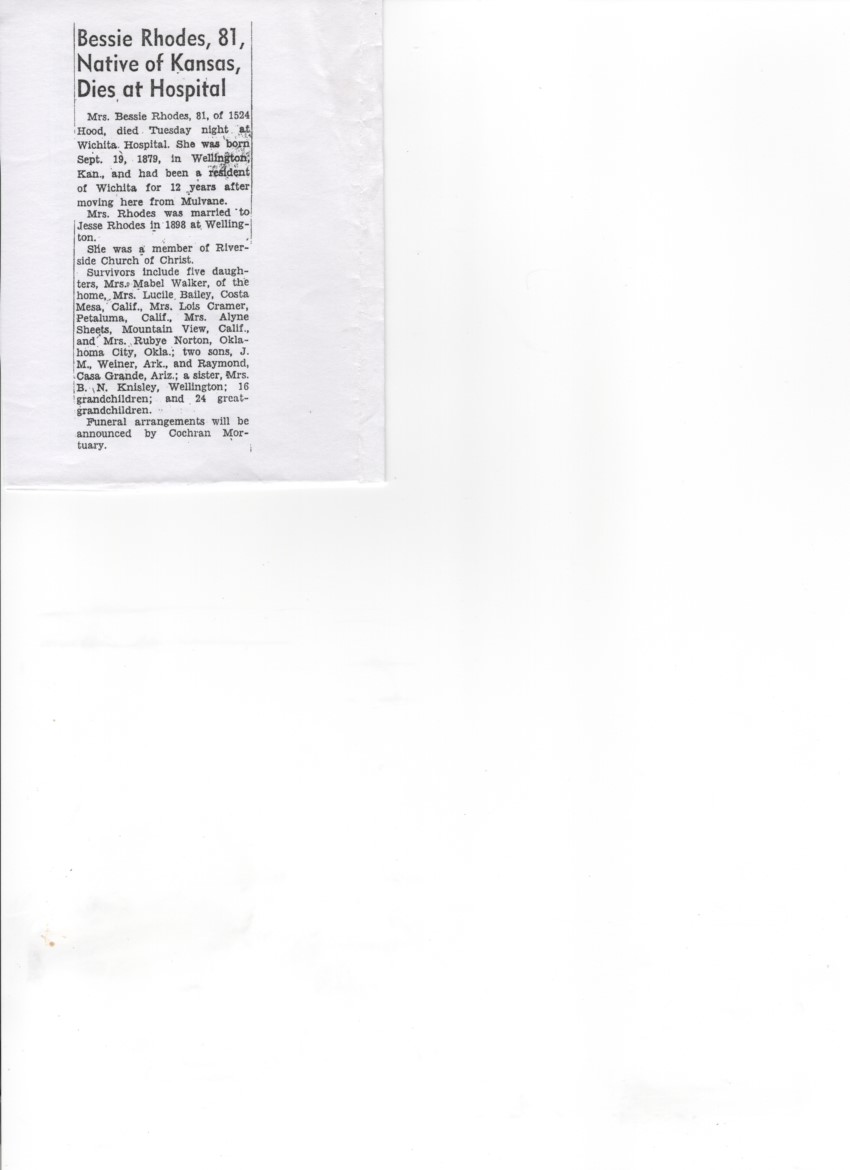Seldom if ever, is something accomplished by one person alone. Maybe someone like Thomas Edison might be the exception. But sometimes we know very little of the “other people” involved. But Leander’s Setters Lake, when completed and then improved, and after Leander grew old and frail and especially after his death, like all things involving nature, began to self destruct. That’s the natural way. It needed care and upkeep, and during the following two decades after the first gallon of water flowed into it, nature began to take its course, and its toll.
Big sycamore trees leaned out over the little reservoir. Billions, perhaps even trillions of their leaves fell into the water, rotted and became mud. Muddy water flowed into it, lake moss formed on its surface, at times totally covering it. Leander’s Lake needed help. And help was on its way, but not until nearly half a century after Leander died. The major attention was given by Leander’s great-grandson, Jim, named after Leander’s own son. But Jim was married, his two grown children, and his wife Dana had to become voluntarily involved.
A quagmire offered, or perhaps she simply knew that in Jim’s heart this was his destiny. Strangely enough, Dana either saw the potential that the lake, by now, nothing but a swamp, was Jim’s destiny and hers.
But Dana didn’t just get there. Fate fought her every step of the way. We begin with her Grandmother Bessie. Except for a very devoted mother, Bessie might have simply disappeared into an Osage Indian culture. And Jim might have married someone else and that someone might not have accepted the Setters Lake challenge. And, Leander’s lake, would have surely just become an ongoing quagmire forever.
In the forward to this story the mere compilation of genetic data and the minimal importance it usually deserves, is given a lot of emphasis. But if we pursue the lives of the ladies who in some way, directly or indirectly, concerned that little body of water, we must place them in order of how they appeared. This is difficult to do, because at times they faced the same challenges and often times, were, in some instances, a century apart.
Louisa, Leander’s first love and first wife, never saw the lake as any size. Although it was there as a smaller ice pond when she arrived in 1888.
She had been on various kinds of boats on the Ohio, Tennessee and Cumberland rivers anyway, so a little small pond down in a hollow in the
hills of Tennessee would not have been very impressive. And she was confined to a crude wheelchair of sorts and in pain from severe arthritis.
It was eighteen years after her death that Leander had his men scoop out the muck and mire and another few years before the name Setters was attached.
For years, Leander’s offspring thought he had actually built the lake. Even the author of this story, when he began writing about the Lake, was under the impression that he did. But according to historical research by John Graves of northwestern Davidson County, the pond was there as far back as 1871. And its main purpose was for making ice.
In fact, it was this picture that caused the family to believe that Leander DID make the lake. But after careful scrutiny, it has to be assumed that the men were using mules to simply clean it out. The scoops in the picture with the mules are a bit small for major dirt construction.
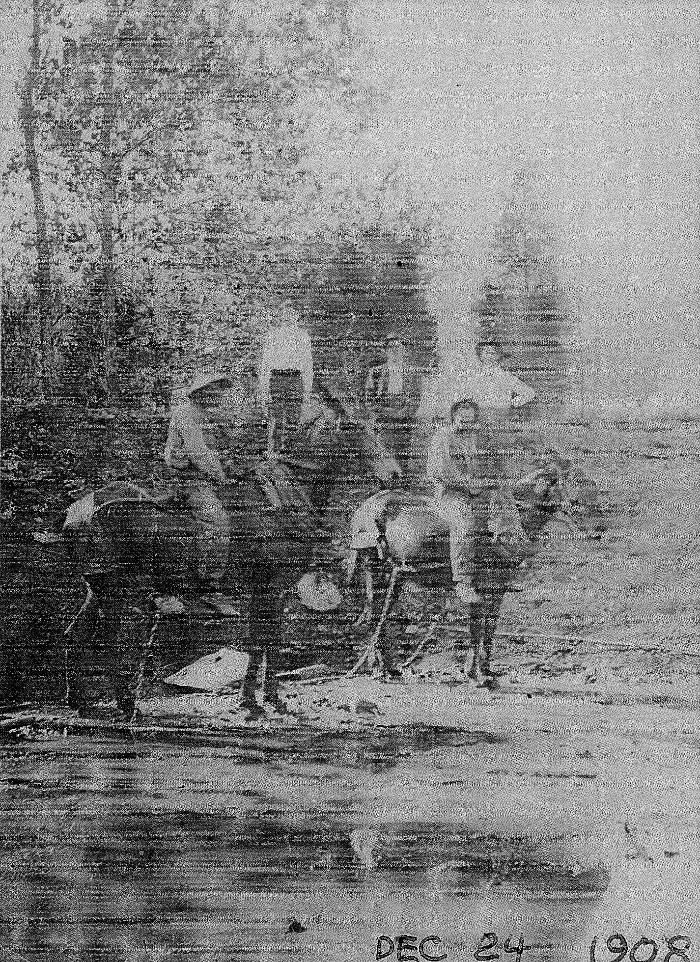
That is exactly what happened when Leander’s great-grandson, Jim with his wife Dana, came back forty-two years later, did the very same thing, except Jim and Dana hired bull dossiers and back hoes to do the work. The scoops in the picture with the mules are a bit small for major dirt construction.
But Bessie played an import role in getting Setters Lake back or what it had been, and probably even better than it ever was. Of course, Bessie never saw the lake and never even knew that it existed. But her granddaughter Dana did, and her granddaughter was married to Leander’s great-grandson and that is when things began to happen.
Other than almost being bought by an Indian chief because of her red hair, Bessie did more than bring into the world nine children. When her ninth child was about two years old, her husband Jessie died. Jessie had been an educator, a teacher and very dedicated to making sure his nine children were academically challenged. The grandfather of Dana Setters moved his family often as he took various positions as a teacher.
Let us do a little of the family tree thing. In some cases, it just has to be done. It can be boring but oftentimes necessary, as it is here. Bessie’s father was J.W. Smiley. Bessie’s mother’s maiden name was Helen Dixon Esson, daughter of George and Sarah Esson. George and Sarah had moved to Kansas from Canada when Helen was nine years old.
Helen’s mother was Sarah Wharton. Sarah’s mother was Rhoda Hathaway. She married Benjamin Wharton. This takes us back seven generations. Sarah’s father, Benjamin, was a “minister of the gospel”, a preacher, and they lived in Indiana. Helen, Dana’s great-grandmother, was born June 7th, 1854, in Peterborough, Canada, northeast of Toronto and due north of the Great Lakes. Peterborough, founded in 1825, but not incorporated for nearly a century was named after Peter Robinson. He had helped many Irish immigrants into the area. It is unusual that only his first name was used in naming the city.
And why Helen’s parents, George and Sarah, went through the hardships of moving to the windswept isolated rugged and unsettled area of Kansas will never be known in 1863 right in the middle of the Civil War. Kansas was not even made a state until 1861 and Oklahoma, not until forty years later. The entire area was just a dumping ground for the Native Americans that were being moved out of the Eastern United States.
Helen was nine years old when her parents moved from Canada to Kansas, so she remembers traveling. From that point on though, until she was a mother, most if not all, of her traveling was done by wagon, buggy or horseback. There is absolutely no way she could have even imagined her little red-headed girl, whose hand she was hanging onto, could one day be the great-grandmother and great-great-grandmother of two young women who would travel thousands of miles from that crude and ram-shackled Kansas pioneer prairie farm.
And these two young women, without even changing their socks would travel thousands of miles in less time than it would have taken the Smiley family to go to town and back, by a horse pulled wagon.

Claire, Helen’s great-great-great-granddaughter, with Bessie’s red hair, traveled to Argentina in South America when she was twenty-one years old. Her primary reason was to stay with an Argentine family to strengthen her Spanish speaking. “Unfortunately,” said Claire, “They wanted to strengthen their English.” While there, she traveled to the Andes Mountains and someone with a camera took this picture. Her mother, Carol, on her 24th birthday stood on a different stage, eight years before Claire was born. She sang in one of the beautiful ballrooms of a hotel in Paris France with the reformed Glenn Miller band. Both had memories that Helen would have cherished. Claire was already, when born, closer to a mountain much taller than Cerro Lopez. She would be just 24 ½ miles from Long’s Peak, in Boulder County, Colorado that elevated over fourteen thousand feet, twice the height of the Argentine peak and nearly six thousand miles closer. Two people every year are killed as they are climbing Long’s Peak. As a baby in Boulder, Colorado, born in an invitro twin with her brother James, she was just 1700 feet lower than she was when saluting the mountain in South America.
Carol, when she reached the age of sixty-five, and became eligible for Medicare lived within five minutes of Claire, back in Boulder County, Colorado and helped Claire with Claire’s two children, Carol’s grandchildren. They both were a mile (5,280 feet above sea level and far above the near sea level, in Wichita, Kansas (elevation 1302 feet) where Carol began her life early the morning of November 4th in 1956, when Bessie was about eighty years of age.
Other than the Essons, all the rest of our families that ended up in Kansas, came from New York, Ohio, Illinois or Indiana. Most, if not all, were responding to being military veterans of the Civil War. As our story unfurls you will be introduced to all of them.
The year Kansas was made a state, in 1861, Hester Van Camp, in Indianapolis, Indiana, decided to pour some tomato sauce into a favorite family navy bean recipe and took the first step toward the now famous Van Camp’s Pork and Beans. By the time Leander first began digging in the lake it was a best seller in the nation. To show how claims in advertising were already beginning to intrude into Leander’s culture an independent weekly journal for merchants, TRADE, in their January 1908 edition, featured a claim by Van Camps that their pork and beans were better than home cooked.
But the United States government had begun the Homestead Act and those who wanted to own their own property in that desolate part of the country could move there and apply. So, it is assumed that is what George and Sarah had done. One thing for sure though, had they not moved to Kansas, Helen would have never met J. W. Smiley and there would not be a Bessie and much of this story would not be written.
At the age of twenty-one, just before Christmas in 1875, Helen married J. W. Smiley in Lawrence, Kansas. J.W. died just fifteen years later in 1890 but not before he had fathered two sons and two daughters. One of the sons, Edward Esson Smiley, who was thirty-five years old when World War One ended and who had registered for the draft but was never drafted, died in 1929 at the age of forty-seven. That was the year that Leander Setters’ second wife, Aletha, died.
Another of Helen’s daughter, Pearl, married and moved away from the home. The other was Bessie. Several years before his death J.W. and Helen had moved their family to a farm near Perth, Kansas as homesteaders. Helen, to be known later as Grandma Smiley, lived on that farm for seventy-one years, fifty-seven years as a widow. And she died there, painfully.
Helen, Grandma Smiley, below, looks like a small frail little old lady as she stands between Bessie on her right and Lucille, one of Bessie’s five daughters, and Helen’s granddaughter, but Helen had lived a tough and demanding life for many years. This picture was taken a short time before the fire that took the life of this small but strong little pioneer woman.
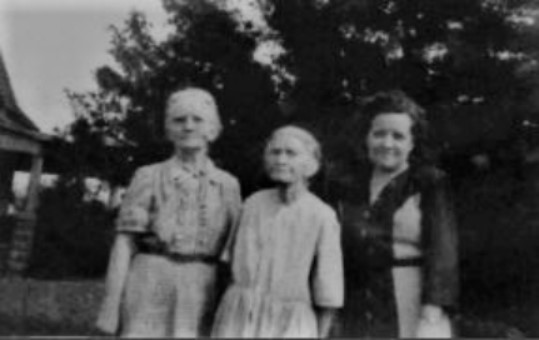
And pray tell, how does that little lady fit into the Ladies of the Lake? Well, if you mean, did she walk around the lake like Mabel, or raise three boys who swam in the water, or marry a homesick man and help him put it all back together, the answer is no, she didn’t fit in the picture like that. But remember she stood there while some Native American tribal chief tried to take her little red headed daughter. And this daughter brought into the world another daughter and she and her daughter were included in that group. Would you have left Helen out? Don’t think so.
All of her children moved on to live their lives except one son, Marion. Marion was mentally challenged but was a good worker on the farm. Some of Helen’s great-grandchildren visited her a couple of times and were amazed at Marion’s memory. They would tell him their names and Marion would tell them the day and date they were born. The children knew him as Uncle Marion. It’s doubtful they also knew he was their grandmother’s brother.
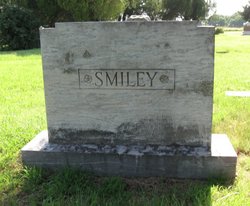
Marion Smiley Dec 1877- 15 Jan 1957
During all of this, what about the events that were shaping the life of Mabel? Mannerisms and life philosophy were being formed that would have their influences throughout her life and, the lives of those who followed.
Mabel’s parents lived in Rome. Mabel was born in Perth. You geography students will quickly assume that Mabel was born to immigrants. These two cities, the ones most people know about; Rome in Italy and Perth in Australia are many miles apart; actually, thirteen thousand three hundred and thirty-one miles apart. But the Rome and Perth we have reference to were in southern Kansas, in Sumner County just south of Wichita. Rome Kansas, as such, does not even exist anymore. Over time the little community simply disappeared, house by house. Rome and Perth were only twenty-one miles apart. You can make twenty-one miles in about fifteen minutes by car these days. In 1902, by horse and wagon or buggy, it would require over four hours. So, about to have the baby Mabel, Bessie climbed up into a wagon or a buggy and made that four-hour bumpy ride to where she could get help. Most if not all of you reading this were born to a woman who was given a smooth, safe and comfortable ride to a well-equipped hospital where a highly skilled medical professional attended your birth.
For some reason not known to us, twenty-three-year-old Bessie Rhodes thought it best to go to Perth, maybe to the house of a friend or at least to someone who could help her give birth. She was not in a hospital, there was none in Perth., and apparently there was no one in the Rome community that could help her. Instead of the signature of an attending physician on Mabel’s birth certificate, there is the name, Mrs. Ed Brothers, midwife. At that point in time in our culture, married women did not use their first names in any official capacity, they used the Mrs and her husband’s first name and, of course, his last name.
For Bessie, having a baby was not a new experience as she had done it twice already. She had a boy first, then a girl. At that time in our medical culture there was no way of finding out the gender of the baby she was about to have. And she was destined to perform the same feat six more times.
As Bessie was giving birth to Mabel on June 12th, 1902, there was another lady not far away, now an hour’s drive, in Medicine Lodge, Kansas, getting ready to make a change in her life. Caroline Amelia Nation, often referred to by Carrie, Carry Nation, or Hatchet Granny, was born November 25, 1846, in Kentucky as was Leander Setters, and was a radical member of the temperance movement, which opposed alcohol before the advent of Prohibition. Nation is noted for attacking alcohol-serving establishments with a hatchet. She was six feet tall.
The famous saloon smasher Carrie Nation was getting ready to go on a rampage that made her famous. She sold her house in Medicine Lodge. She had lived there since 1889 and the little house is still there as a museum. Carrie used the money she got for the house to open a home in Kansas City for the wives of drunkards.
Carrie had married a drunk in her earlier years, but this six-foot tall lady soon got rid of him. At six feet, she towered over the women of the time whose average height was just over five feet.
Mabel’s grandfather, David Rhodes, was only five feet six inches.
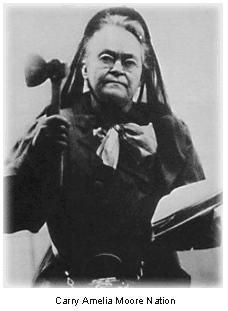 When Carrie and her group of angry women stormed into a tavern with Carrie swinging her hatchet it must have been a sight to behold. That doesn’t mean you have to be big to be a handful.
When Carrie and her group of angry women stormed into a tavern with Carrie swinging her hatchet it must have been a sight to behold. That doesn’t mean you have to be big to be a handful.
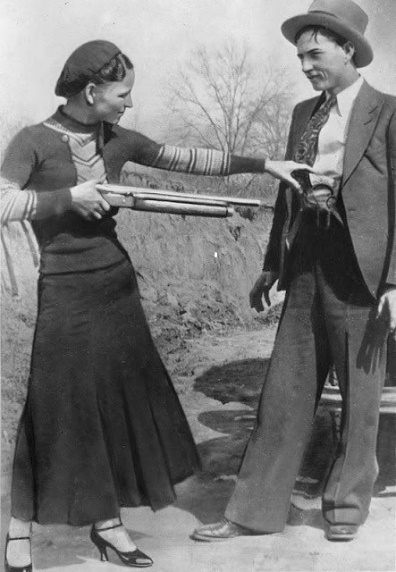 Bonnie Parker of Bonnie and Clyde fame stood only four feet eight inches and weighed just eighty-five pounds. Bonnie was born in Texas in 1910. Her father died four years later, and the family plunged into poverty. She was attractive and wrote poetry.
Bonnie Parker of Bonnie and Clyde fame stood only four feet eight inches and weighed just eighty-five pounds. Bonnie was born in Texas in 1910. Her father died four years later, and the family plunged into poverty. She was attractive and wrote poetry.
Some of us leave something behind as a token of our being here. This is the car that Bonnie and Clyde were in when the shooting stopped. Their bodies had a total of 167 bullet holes.
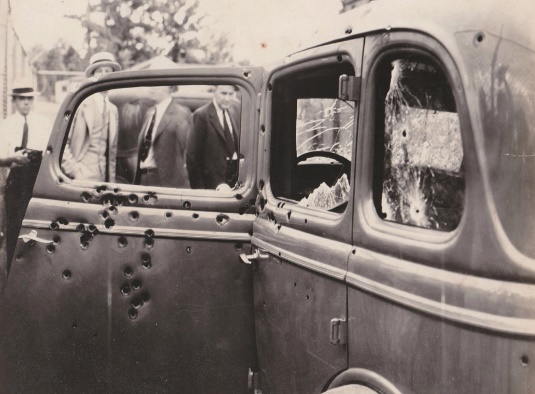
Bessie was barely five feet tall and her mother, now known as Grandma Smiley, was even smaller. Small but mighty. Neither of them ever stormed into a tavern or even went to one. Carrie Nation did, many times.
Bessie and her mother did all their good works in the Church. Even though their father died at an early age, two of Bessie’s sons became Elders in their Church and one of them in his later years was the superintendent of a Children’s Home. Bessie’s granddaughter, Dana and husband Jim, were a house parents there. Although Bessie didn’t wield a hatchet as did Carrie, she nonetheless, left a legacy.
Mabel was eight years old, and the family was still living in southern Kansas on the farm and in near poverty when thousands of miles away another baby was born to an Albanian couple in central Europe. She too would be small, growing to just five feet, much the same size as Bessie. She would grow up to be a beautiful young lady as you see here, Agnes Gonxha Bojaxhiu.
But, although just five feet tall she would grow to be a giant of a person. You will know her as she appeared in later years after dedicating her life to the salvation and comfort of others, as Mother Teresa. She was born just two years after Leander Setters began building the lake, and fifteen years before Mabel was married.
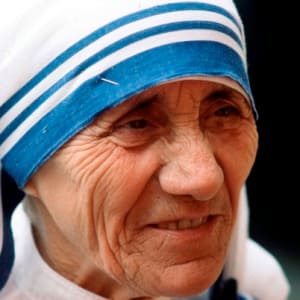
All of these ladies, Helen, Bessie, Mother Teresa, Bonnie, Carrie Nation were small, but they all were strongly influential in their lives and as Mother Teresa put it in a poem that easily could also reflect the thoughts of Bessie and Helen, although Bessie and Helen were certainly not Catholic.
It is not how much we do,
but how much love we put in the doing.
It is not how much we give,
but how much love we put in the giving.”
Mabel, one of nine children, was moved around a lot as her father, Jessie Rhodes, taught at various schools in Kansas and Oklahoma. A few months before Mabel was born, a ship, the SS Dresden, docked in New York, on February third, 1901, bringing a Jewish family, the Pashelinskys, from Lithuania. Shortly after the Pashelinsky family arrived in America, they changed their last name to Parrish. Their son, Michael Hyman Pashelinsky, was a few months younger than Mable. He thus became Michael Parrish. As he began to make headway in show business musical lyric writing, he changed his first name to Mitchell.
Among other musical accomplishments, he wrote the lyrics to Hoagy Carmichael’s Stardust. Mitchell died in 1993 at the age of ninety-two.
Hoagie put the music to Stardust on paper the year Mabel’s first of three children was born in 1927; a daughter, they named Shirley. Mitchell added the lyrics in 1929, the year Mable gave birth to her second child, a boy, they named Hugh Bruce. It was also the year the terrible depression began. A young and upcoming crooner baritone, Harry Lillis Crosby, Jr. recorded Stardust August 19, 1931, just three months before Mabel gave birth to her third child, a daughter, they named Dana. Stardust became the most recorded song of the twentieth century. Harry Lillis Crosby is best known as Bing Crosby. Until Dana provided Mabel with two grandchildren, a boy and a girl, no one in the Rhodes family had shown any musical talent and as far as is known, the family never owned a musical instrument. You’ll read about these two, Carol and John, later.
Let us hope that the remaining six babies born to Bessie were easier and far less complicated than giving birth to Mabel But over the next ten years Bessie was either pregnant or just getting over having a baby. And this was not unusual for those times. Just down the road a few miles, when Bessie was giving birth to Mabel, a lady named Gertrude was about to give birth to the second of ten babies. Mabel and that baby would meet about half a century later. And be grandmothers to the same two grandchildren.
Throughout this story it will be noted how many children were born to women in the various families. Bessie had nine, Gertrude Roberts had ten and some of the ladies had as many as thirteen. The need for farm helpers is given by some for this large numbers. Some give the reasoning to a lack of contraceptives. Having condoms readily at hand and the logistical hardships of buying them obviously played a role. But condoms in some forms have been available since ancient days. Cold winter nights and snuggling more than likely played a role in the population increases
In the United States in 1800, the average woman of childbearing age would have seven children over the course of their lifetime. As factors such as technology, hygiene, medicine and education improved, women were having fewer children than before, reaching just two children per woman in 1940. This changed quite dramatically in the aftermath of the Second World War, rising sharply to over 3.5 children per woman in 1960.
Increased access to contraception, fertility reached its lowest point in the US in 1980, where it was just 1.77. It did however rise to over two children per woman between 1995 and 2010, although it is expected to drop again by 2020, to just 1.78. Without immigration, the population of the United States would lesson at this rate.
But back to our story with Bessie living in Wichita and her mother living with Bessie’s somewhat retarded brother on an isolated farm near Perth many years later. Bessie was safe and with her daughter and grandchildren living in comfort. But at night as Bessie laid her head on her pillow, you know she worried about her mother and her brother, alone out there on the farm all by themselves. A worry that was later justified.
So, we had this ninety-two-year- old little woman and a mentally challenged middle aged son putting wood into the stove and somehow the hot coals got out of the stove and set the house on fire. Helen died from her burns. She had twenty-one great-grandchildren. A life that saw many hardships none of her off-springs will ever experience; nor would they want to.
When Mrs. Smiley died in 1947, Marion moved in with his sister Pearl. He died in 1957, at the age of 80. She and Leander Setters were the only members of this expanded family who lived to be ninety-two. It wasn’t until the year 2018 that a male, living in that expanding family lived longer than ninety-two. That male was one of Leander’s great-grandsons, John Raymond Setters, who died at ninety-three.
Helen was six months older than Leander when she died. Both had lost their spouses, he, when he was fifty, and Helen, when she was thirty-five. Helen never remarried. Leander remarried the same year his wife died. But both died without spouses living. And Helen died the same year, 1947, that Leander’s grandson, John, (the father of John Raymond and, Jim, the author of this story) died. Just another of those family coincidences.
So now, we find Bessie with nine children, the youngest about two years old. Her oldest, Lucille, was engaged to be married. A lot of adjustments had to be made including Lucille telling the young man in her life that the wedding was off. She must help Bessie raise her eight siblings. She remained with her mother, Bessie, helping to raise her siblings.
Lucille was, what we would call, an “old maid” schoolteacher. She finally left in the mid nineteen forties to teach school in California. She did, finally, get married but not to the same man she had to abandon.
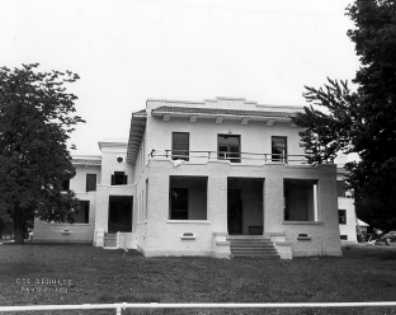 But Bessie still had some hurdles. A widow, with nine children to feed and living in a rented house, she needed an income. Jobs were scarce for women during those years, but she found a job at the Santa Fe Railroad Hospital in Mulvane where she labored for several years as a clean-up person in the operating room.
But Bessie still had some hurdles. A widow, with nine children to feed and living in a rented house, she needed an income. Jobs were scarce for women during those years, but she found a job at the Santa Fe Railroad Hospital in Mulvane where she labored for several years as a clean-up person in the operating room.
Probably the worst job there. The children grew up, and all but Lucille left home and began their families.
The youngest of Bessie’s children, Raymond, 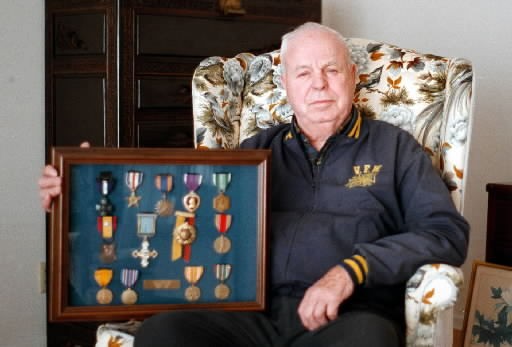 nicknamed “skinny” who was about two, when his father Jessie died, joined the Army and flew the now famous P-38 Lightning fighter planes against the Japanese over the “hump” in India during World War II. He was in the same outfit that included this man, Rex Barber, flying a P-38, who had shot down the plane carrying Admiral Yamamoto, the Japanese admiral that planned the Pearl Harbor attack.
nicknamed “skinny” who was about two, when his father Jessie died, joined the Army and flew the now famous P-38 Lightning fighter planes against the Japanese over the “hump” in India during World War II. He was in the same outfit that included this man, Rex Barber, flying a P-38, who had shot down the plane carrying Admiral Yamamoto, the Japanese admiral that planned the Pearl Harbor attack.
After the Pearl Harbor attack, did Yamamoto say, “We have awakened a sleeping giant?”. He did not. The Hollywood version had Yamamoto having said that for its emotional effect on movie goers It was the commander of the attacking Japanese planes who used his plane radio to announce the Americans were surprised. Tora Tora Tora means Tiger Tiger Tiger. And very few people may now remember the name Mitsuo Fuchida (1902-1976).
But the radio code he sent 80 years ago, “Tora Tora Tora” (Surprise attack successful), remains broadly known.
They just put that in the movie about Yamamoto saying that, for effect, about the December 7th, 1941, attack.
 Although “Skinny” was raised by a very religious family, the plane he flew was named The Forked Tail Devil by the Japanese enemy. Later he was a crop duster in Arizona, lived in a little trailer and died of a heart attack. He never married. An older brother, “Billy” fought in Europe against Hitler’s army.
Although “Skinny” was raised by a very religious family, the plane he flew was named The Forked Tail Devil by the Japanese enemy. Later he was a crop duster in Arizona, lived in a little trailer and died of a heart attack. He never married. An older brother, “Billy” fought in Europe against Hitler’s army.
We have no idea if Skinny ever met Barber or Sgt. Orvon Grover Autry. During the war, Autry, was a crew member on a C-47, that ferried fuel, ammunition, and arms in the China-India-Burma theater of war and flew over the Himalayas, the hazardous air route known as the same Hump. Orvon later gained fame and fortune as the singing cowboy, Gene Autry. Gene was THE cowboy star before the war but was replaced by another young actor named Leonard Slye.
We know Leonard as Roy Rogers. The two only appeared in the same movie one time, and the less popular at the time, Leonard Slye, had to use his real name. Roy Rogers’ first wife died in childbirth. Later he met and married Frances Octavia Smith. We knew her as Dale Evans. She got her start in Memphis as a singer, the same place as Elvis Presley, years later.
Roy starred in fifty movies during World War 2. He did not, as did Gene Autry, enlist during World War Two. He and John Wayne were 1-A in the draft but were exempted because of age or because they had children. Both could have enlisted, but neither did. Roy toured with USO and did war bond rallies. It is said he sold more bonds than any other Hollywood star.
Roy Rogers and Dale Evans starred in twenty-eight movies, but they never kissed on the screen. Their last movie was shortly before Bessie’s granddaughter, Dana, married Jim Setters in 1950. Jim and Dana did kiss right after saying “I do”, but Bessie in the picture, below didn’t look.
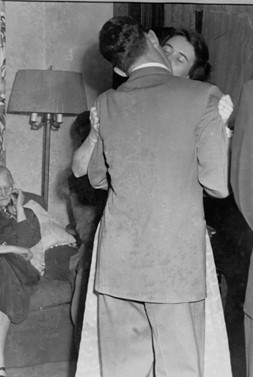 Notice that Dana has her eyes closed, and that is nice. Also, notice how Dana is clinging to Jim’s suit at the shoulders as if to say, “Gotcha.” Bessie didn’t notice though, she just looked away; mustn’t look you know. You will see her sitting in her favorite chair in her living room just below the lamp globe.
Notice that Dana has her eyes closed, and that is nice. Also, notice how Dana is clinging to Jim’s suit at the shoulders as if to say, “Gotcha.” Bessie didn’t notice though, she just looked away; mustn’t look you know. You will see her sitting in her favorite chair in her living room just below the lamp globe.
I wonder what Bessie’s answer would have been had you walked up to her when the picture was taken and asked her, “And what does the future hold for you my dear?” She may have answered your question with another question. “Has it only been thirteen years since we were told we would never see Dana again?”
As the cowboy movie stars Roy Rogers and Dale Evans were ending their careers in the movies, Bessie was beginning her life as a great-grandmother. She would also soon welcome some royalty into the family. While stationed in Hawaii, Bruce, her grandson, fell in love with the great-granddaughter of an Irish sea captain and a Samoan princess.
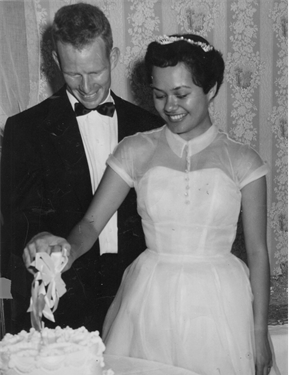
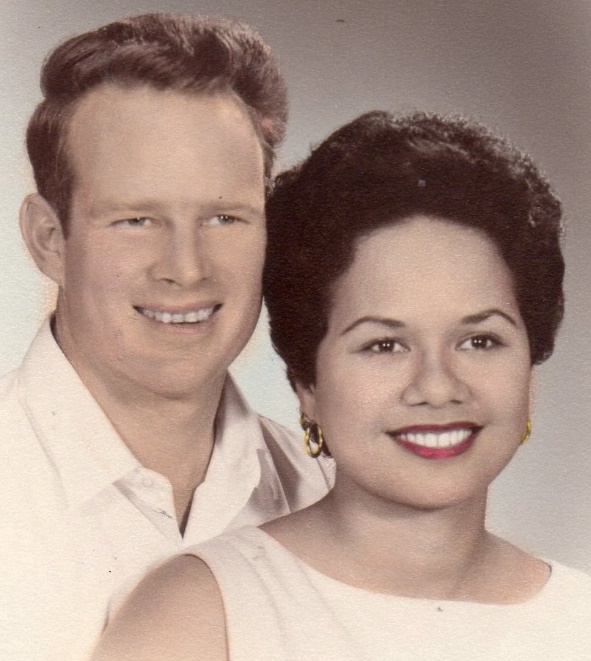
Bruce and Lei Chapman
The wedding was at the same Church in Wichita where Dana met Jim five years earlier. Lei, as she gazed into Bruce’s eyes, sang the Hawaiian Love Song, one of the few times something, other than a hymn, was sung at that Church. The reception was held at Bessie and Mabel’s house, and in front of that same fireplace.
Mabel was living at Setters Lake when she was advised of her son Bruce’s death twenty-seven years later. Like his father, Bruce’s death was sudden.
And in six years, Bessie will watch as her daughter Mabel, mother of Dana and Bruce, standing in front of that same fireplace, is married. About a month later however, Mabel will be a widow. And then, mother and daughter will be together again.
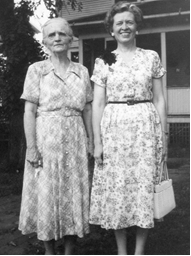 This picture shows mother and daughter, Bessie and Mabel, posing for a picture in the backyard of the home at 1015 Lewellen in Wichita, Kansas, the house where her granddaughter Dana married Jim Setters, her grandson Bruce married Lei, and where Mabel had married Chet Walker.
This picture shows mother and daughter, Bessie and Mabel, posing for a picture in the backyard of the home at 1015 Lewellen in Wichita, Kansas, the house where her granddaughter Dana married Jim Setters, her grandson Bruce married Lei, and where Mabel had married Chet Walker.
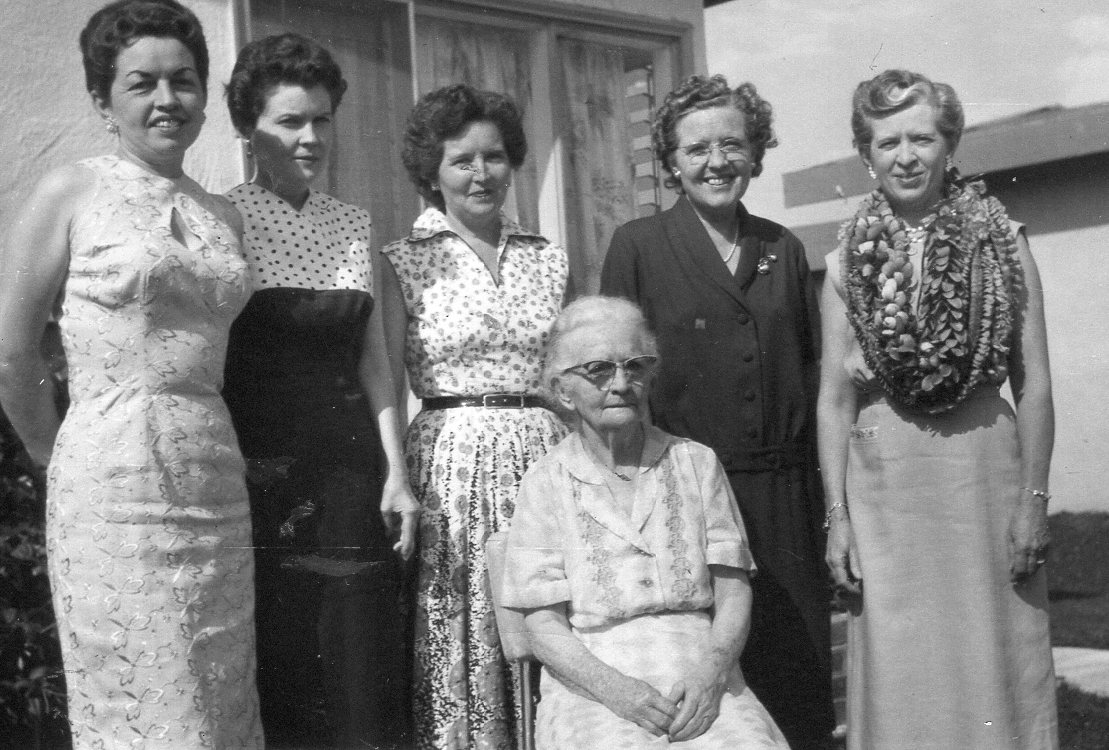
Alyne Ruby Lois Bessie Lucille Mabel
Bessie was cherished by her entire family and in 1958 was given her 79th birthday celebration by her five daughters. By this time, two of her four sons had died from heart failure. In a few weeks this lady, once admired as a red-haired little girl by an Indian chief, would be admitted to a home for the aged and die at the age of 81. Not one of these ladies ever heard about Leander’s Setters Lake and it would be another twenty years before Mabel would be walking around it.
There were more changes yet for Bessie, who by now was almost eighty years old. She was a widow for over thirty years, but not living a lonely life. The lonely years were just ahead. And they came, as they will to most of us. This remarkable lady, now leaving her seventies, who at one time was the matriarch with as many as ten offspring living in her home was about to be alone. Some of her children, now middle aged, lived nearby but others she saw only occasionally as they traveled to Wichita from California, Arizona, Arkansas and other locations.
Now, Bessie’s future was getting ready to be determined by a former railroad conductor, Chet Walker. A tall former boyfriend of Mabel. Remember?
Chet, father of three grown children of his own, was widowed. His health was failing. He was being cared for by doctors and nurses at the Wesley Medical Center in Wichita, Kansas. By now, Mabel was a laboratory technician at Wesley.
One of her duties was to draw blood from patients for analysis. In her white uniform and carrying her tray of syringes and vials, she walked into a room and there lay Chet Walker. Bingo! The old flames were crackling, and the long-ago love affair was on again.
Mabel was now living with Bessie. Just the two of them, with occasional visits from Bessie’s children and some of Bessie’s grandchildren and great-grandchildren.
This re-kindled love also served well for Jim and his work as News Director at a Wichita radio
These late in life decisions are not without problems and causes of upheavals in family relationships and for Mabel it meant many things. She had lived without a man in her life for about twenty years. She was now a grandmother, a provider and companion to Bessie. It was abandoning this role as a companion to her mother that bothered her most.
Her mother had stood by her for a quarter of a century; and no doubt remembered when Chet courted Mabel way back in the mid-twenties. But Mabel instead married Les Chapman and brought Bessie three grandchildren. Bessie shared the turmoil when Les virtually kidnapped and sold Dana in the middle of the great depression and terrible dustbowl days.
Bessie was now a great-grandmother. That poor woman had seen it all, herself giving birth to and raising nine children of her own, many years of that time, a widow. It was now 1956; two years later she would lose a son, Bill, to a heart attack at age fifty-nine. Bill was gone forever, but in a few months, Mabel would return.
But in the summer of that year, 1956, Bessie had no way of knowing this. All she knew was that she was alone for the first time in her life. Being alone during the day was nothing new for her, most of the time everyone had outside activities. But as darkness settled in Bessie felt the loneliness.
Her home that for years bustled with family behavior in those hours before bedtime now was quiet. It was a quietness she was not acquainted with. The lonely days had arrived. Mabel and Chet had married and began their lives in a house on the other side of town in Wichita.
Mabel’s two daughters, Shirley and Dana already had children. Shirley had two and Dana, one. And Dana was about to have another.
It was just six years since Dana and Jim’s station. KFDI used one of Chet’s children, Jack, a dispatcher with the highway patrol helped Jim many times in unraveling difficult news assignments. Jack discreetly gave Jim tips. You know, blood is thicker than water.
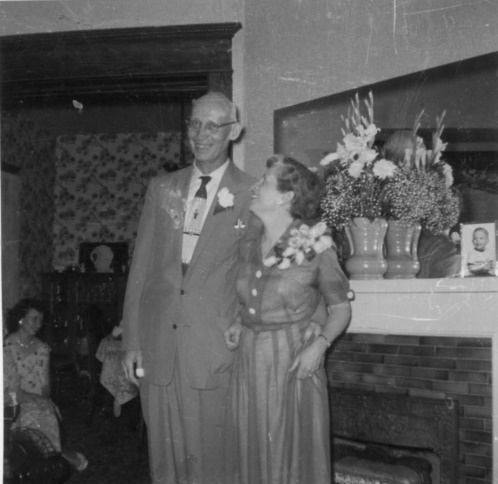
Jim Setters stood in front of the fireplace in that house to be married. Mabel and Chet were joined in matrimony standing in front of that same fireplace. If you look closely, you can see Dana in the lower left part of the picture. She looks happy, as does her mother. On the mantle is a picture of one of Mabel’s grandsons, Chris Pinkham., one of Shirley’s two sons.
It isn’t often one has a picture nearby of a grandchild when one is getting married. The fireplace had long since been unable to burn wood. But there were warm glows those two nights.
Bessie sold the big house where she had lived for eight years with Mabel and Mabel’s children, Shirley, Bruce and Dana. Bessie bought, with Mabel’s help, a smaller house a few blocks away. And thus, began a life alone. Mabel and Chet married and began their lives in a house on the other side of town in Wichita.
Chet and Mabel were happy newlyweds. Dana was pregnant. Chet was a very sick man but was anxious for the birth of a new grandchild. His own two sons and daughter had not yet given him a grandchild. He said he wanted a little red-haired granddaughter. In the fall of 1956, the year they were married, Chet and Mabel began a trip, by train of course, to visit Mabel’s sister in California. Near Denver Chet became very ill and they had to make a quick return to Wichita where he was admitted to the hospital. A granddaughter was born three weeks later, in 1956, but Chet passed away just before that event. The granddaughter did have red hair. She was named Carol Louise, (Louise was Jim’s Mother’s Middle Name)
Now, Mabel was single again, this time as a widow. Chet had made it possible for her to have enough money to buy a house, not far from where Bessie was living. Bessie was now in her middle seventies. As they say. “Growing on eighty” The long hard life had taken its toll. Mabel bought a home in the Riverside area and sold the house where Bessie was living on Lewellen. Now, the two once again lived together and shared their home with Mabel’s children and Bessie’s grandchildren.
Mabel continued to work at Wesley and Bessie grew older very quickly. It soon became necessary to place Bessie in a nursing home type hospital.
The wife of one of Mabel’s brothers is thought to have been the person who would call nightly after Mabel admitted her mother into the nursing home. The phone would ring, Mabel would answer, and the female on the other end would say in a guttural type of voice, “Murderer” then hang up.
This continued for several days. Mabel told her daughters and one of them whose husband flew Corsair fighter planes from aircraft carriers against the Japanese in World War Two, and who was far from timid, decided it was time to bring this to a halt.
So, Mabel’s son-in-law, Virgil Pinkham, known as Pink, dialed the woman’s phone one night. She answered and, without identifying himself, Pink gruffly said, “Have you made your nightly phone call yet”? There were no more nightly phone calls. Now, Mabel lived alone.
She asked her two daughters to visit Bessie as much as possible. Both had young children and Mabel visited her mother every day. Dana, whose children were three and five years old, took them several times to visit their great-grandmother. Bessie enjoyed their visits immensely but one day as five-year old Johnny stood near her chair she reached down and helped him onto her lap. She held him tightly and rocked slowly and softly hummed a tune known only to her.
The little boy of course knew nothing about old age and dementia, and had no idea that in those moments, in her mind, he was with her many decades ago as one of her own. He just sat quietly and looked over at his mother.
At that point in time, little Johnny didn’t know he was in the arms of a near legend.
And, twenty years later, this little five-year old boy would help move the belongings of Bessie’s daughter Mabel to Little Marrowbone Creek in Tennessee where Mabel became one of the Ladies of the Lake.
Bessie and Leander Setters became partners in a never-ending episode of what went on at that little body of water. But they never met and didn’t even know of the other’s existence.
Bessie died peacefully on October 4th, 1960, at the age of 81. She left sixteen grandchildren and twenty-four great grandchildren. And so ended a great journey. You have followed her from a little red-haired girl in the Oklahoma territory, to becoming the matriarch of a rather large family.
But she left a legacy. Totally unbeknownst to her she was one of the Ladies of the Lake. She never actually saw the lake, and in fact never even knew of its existence. But her daughter Mabel in her final years walked around the lake every day before she went to bed in her part of the home that Jim and Dana built overlooking the newly refurbished and beautifully landscaped little body of water.
Had Bessie’s mother made a deal with the Indian chief…………..well, we know that was not to be. If J.W. Smiley had said that day, “Helen, we can make another little red headed girl, and we could sure use five good horses.” And, had not just one toe of David Rhodes wiggled as he lay in a wagon load of dead Union Soldiers, Mabel would have never seen the lake. And in fact, there may never have been a Mabel; or a Dana.
We don’t know where Bessie got her red hair, but she was not selfish and passed it on down to her great-granddaughter Carol, who passed it along to her daughter Claire, Bessie’s great-great-granddaughter.
But, for Bessie, it played a rather dramatic role in her life. When her parents homesteaded near the Oklahoma border, they had to build a crude “sod” house and had only the bare necessities. Native Americans were still living freely there. 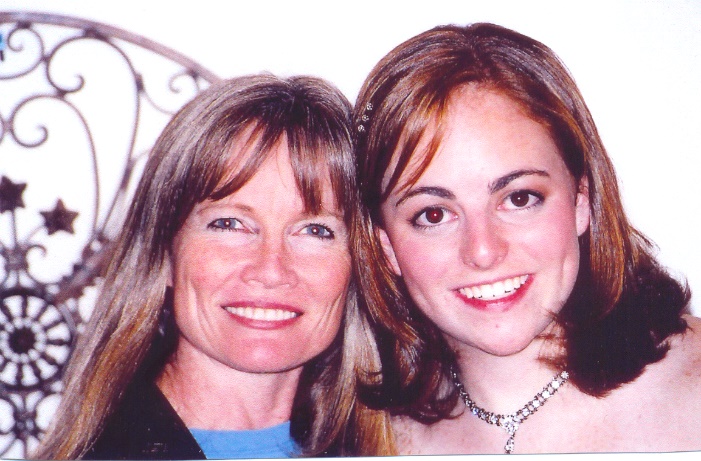
Known then as “Indians” back then because the early discoverers of America had thought they were in India. The name stuck.
The Smileys were farmers and often-times a group or “band” of these male “Indians” would show up wanting food and water. The Smileys, of course, always obliged. One day though the “chief” of the band of “warriors” saw the little red-haired Bessie and took a liking to her. Bessie was just a child, but the red hair intrigued the chief.
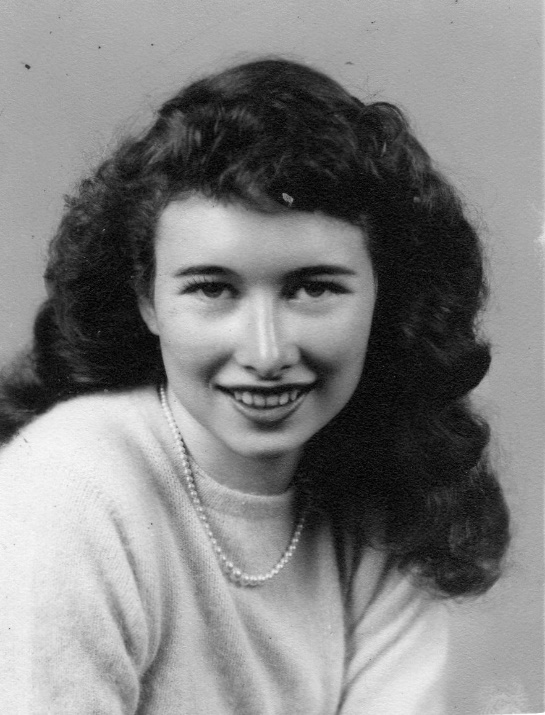 The red hair jumped over Mabel and Dana however, as Dana ended up in High school with long dark hair.
The red hair jumped over Mabel and Dana however, as Dana ended up in High school with long dark hair.
The chief wanted to buy Bessie and offered up to as many as five ponies as a purchase price. Helen, by the Indian standards, should have been honored. She was probably scared half to death. But Helen Smiley, a very small but strong-willed woman, clung to Bessie and of course, refused to sell. This was a good thing for Jessie Rhodes who came into her life about fifteen years later.
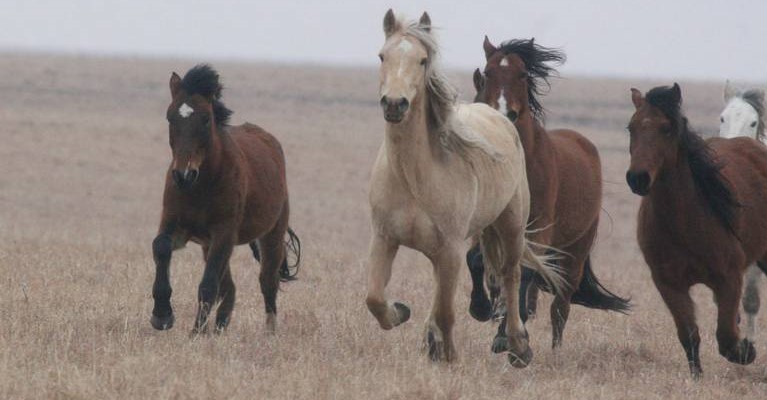
My, oh my, what Bessie’s father couldn’t do with five beautiful horses!
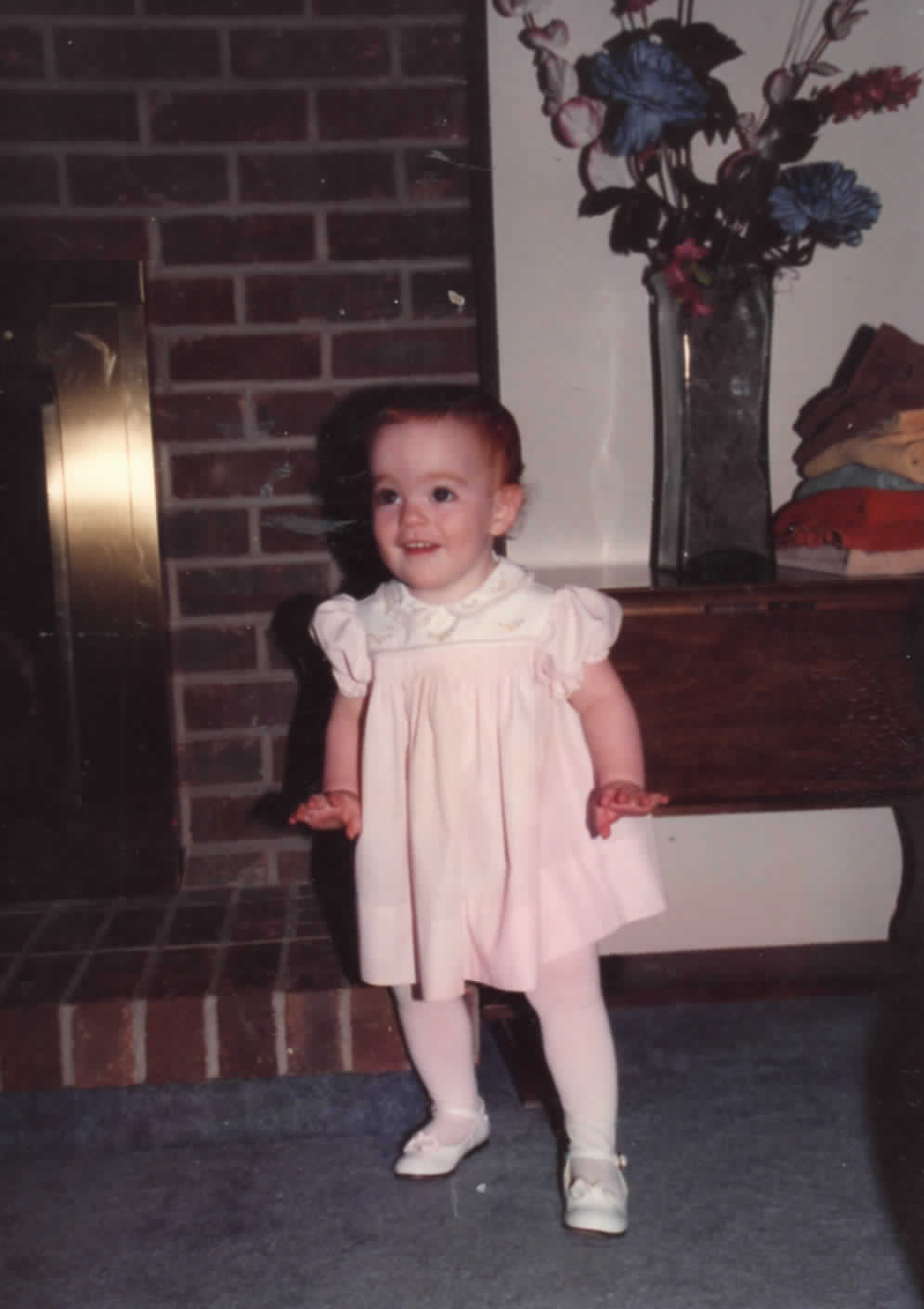
One can surely understand that native American tribal chief’s wanting to take Bessie home with him, if Bessie resembled her great-great-granddaughter Claire in this picture taken nearly a century later.
Claire, thanks to her grandfather Jim’s Mother’s side of the family, would have the tiny bit of native American blood from chief Massasoit Metacomet Yellow Feather from the Wampanoag tribe in the New York area. Chief Massasoit would be back about eleven generations from Claire. After six generations little if no DNA blood line remains, thus the red hair. More about chief Massasoit Metacomet Yellow Feather in another part of our story
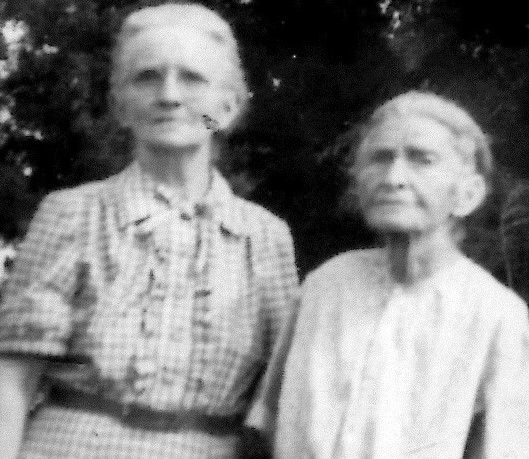
Bessie and Helen, you did good!

You more than earned to be two of the Ladies of the Lake
And two important ones.
